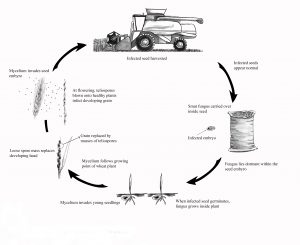Loose smut of wheat is caused by the fungus Ustilago tritici (formerly U. nuda). In Victoria, this disease is rarely seen because the regular use of seed treatments provides effective control of this disease.
What to Look For
Loose smut symptoms do not become apparent until head emergence. At this time heads of infected plants emerge earlier, have a darker colour and are slightly taller than the heads of healthy plants. On infected heads the florets are full of a mass of black spores. These spores are initially held by a thin membrane, which soon ruptures releasing spores. Eventually all that remains of the head is the bare stalk.

Wheat ears infected with loose smut. The ear on the right indicates all that remains after the loose smut has blown free (Agriculture Victoria)
Disease Cycle
Heads of infected plants emerge earlier than those of uninfected plants. The spores released from the infected heads land on the later emerging florets of the healthy plants and infect the developing seed. Infection during flowering is favoured by frequent rain showers, high humidity and temperatures of between 16-22°C.
Infected seed shows no visible signs of infection as the fungus survives as dormant hyphae in the embryo. When infected seed germinates the fungus grows asymptomatically within the plant. As the plant elongates the fungus proliferates within the developing spike and spores develop replacing the healthy grain. Eventually the wheat head is a mass of spores, ready to infect healthy plants.
Receival Standards
Grain Trade Australia’s commodity standards allow a maximum of 3 pieces of loose smut infected ear per half litre for all grades. See the table in the introduction.
Control
Using fungicidal seed treatments every year will effectively control this disease. Good seed coverage of product is essential. Following a loose smut outbreak new clean seed should be sourced.



